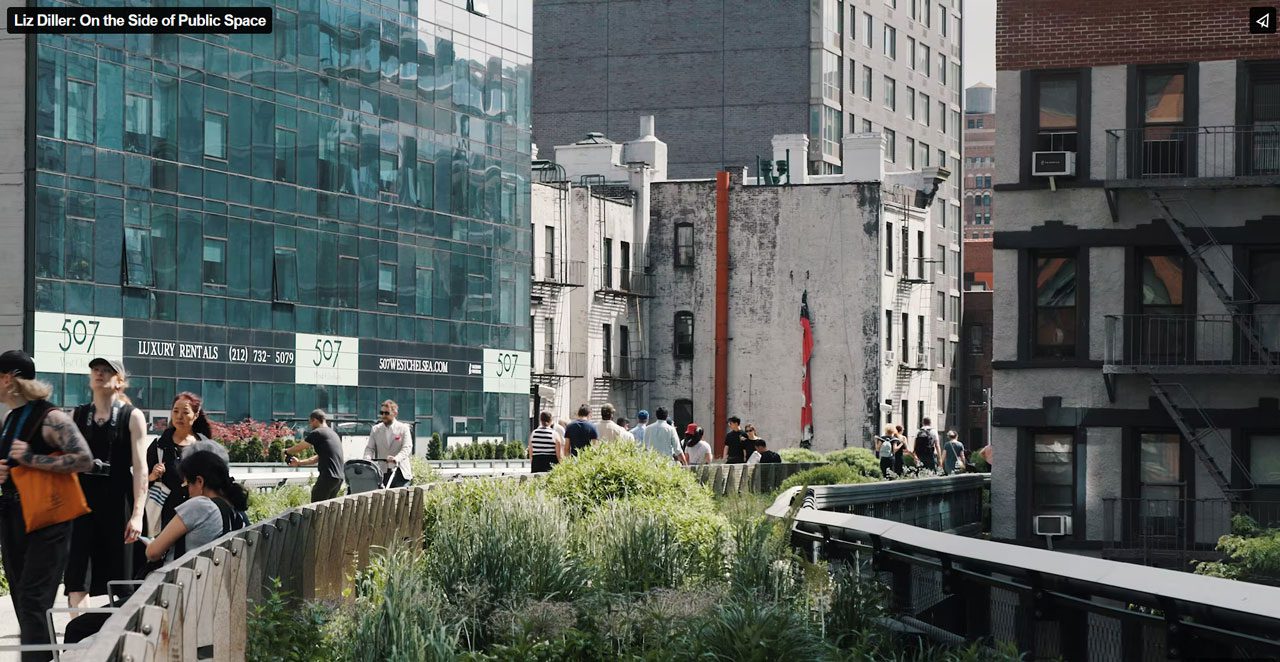VIDEO: Liz Diller-On the Side of Public Space
“The High Line still is a mystery to me. We wanted to preserve this, and we wanted to protect it.” Liz Diller is one of the heroes of contemporary architecture. Even though she never wanted to become an architect. We visited her in her famous New York studio.
“To be an architect, you have to be a mind reader. You have to be an archaeologist. You have to be a psychiatrist and psychologist. You have to be a dreamer and a poet. And you have to be a politician also.”
“All of our work in the studio is about space making. And it’s about the public. It’s about challenging institutions and conventions. It’s just a question of how many legal aspects there are in the way between you and the expression. Sometimes, you have to convince many people, like in our architectural projects dealing with cities. They are very expensive, and so you have to be able to speak with lots of tongues, different tongues, different voices to different people.”
One of Liz Diller’s most famous public projects is the High Line Park in New York. It has become an iconic hangout for the city and a forerunner for similar projects worldwide.
“The High Line still is a mystery to me. When we began in 2003, it was just an obsolete piece of urban infrastructure that hadn’t been used for over 20 years. It was all overgrown in a ruin. And the mayor at that time wanted to tear it down. Already, five blocks were torn down. And the property owners felt that the High Line devalued their property and wanted it torn down so they could build everywhere.”
“But we had this feeling, this sense that the very character of this overgrown, this sort of ruin was so beautiful. It was kind of the city’s unconscious. When you go up there, it is about eight meters in the air, and it snakes through this part of Chelsea and the downtown west side of Manhattan, where you see things you’re not supposed to see. It’s the unofficial New York. It’s not the beautiful New York that’s on a postcard or a splash page for the city, for advertising, for tourism. It is a kind of nitty-gritty, nasty alternative New York, we loved that. And we said that we wanted to preserve this, and we wanted to protect the High Line from architecture.”
Liz Diller sees herself as more than just an architect but a designer and artist. Since the very beginning, working across disciplines has always been pivotal to her.
“Our work is sort of, I would say, across many, many fields. And often, when executing our work, it takes unusual people to help us because we don’t know how to do everything. But when I think about the work that we’ve done, we’re always bringing together librettists, composers, choreographers, scientists, weather experts, meteorologists, crime experts, you name it. We have a curiosity that’s limitless, and we like to explore things we don’t know anything about. In fact, I often say that the best work comes from doing things you’re totally unqualified to do. You just jump off the cliff, and you do it, and you learn, and it’s the best thing you’ve ever done.”
Elizabeth Diller is a partner of Diller Scofidio + Renfro (DS+R). Alongside partner Ricardo Scofidio, Diller’s cross-genre work has been distinguished with TIME’s “100 Most Influential People” list and the first MacArthur Foundation fellowship awarded in the field of architecture. She has also received the Wolf Prize in Architecture. Most recently, she led two significant cultural works in New York: The Shed and the expansion of MoMA. Diller also co-created, directed, and produced The Mile-Long Opera, an immersive choral work staged on the High Line. Diller is a member of the UN Council on Urban Initiatives and a Professor of Architectural Design at Princeton University.
Liz Diller was interviewed by Marc-Christoph Wagner in her studio in New York in June 2024. Camera: Sean Hanley, Edited by: Jarl Therkelsen Kaldan, Produced by: Marc-Christoph Wagner, © Louisiana Channel, Louisiana Museum of Modern Art, 2024
Louisiana Channel is supported by Den A.P. Møllerske Støttefond, Ny Carlsbergfondet, and C.L. Davids Fond og Samling. This film is supported by Dreyersfond and Fritz Hansen

